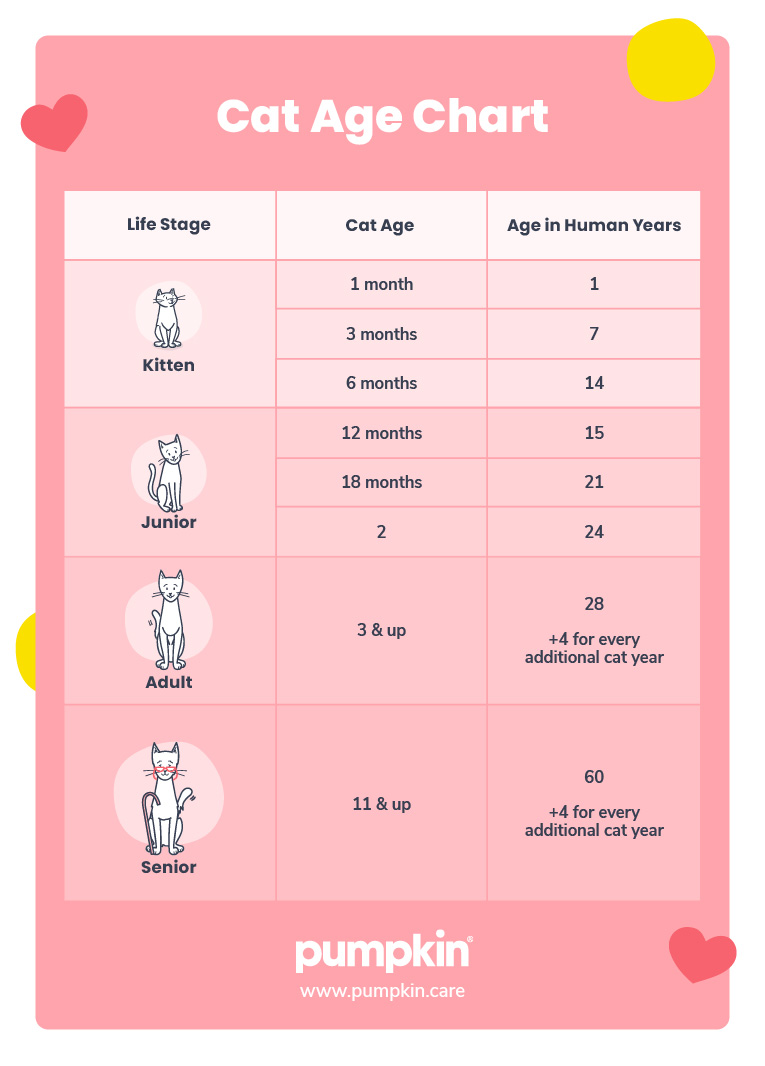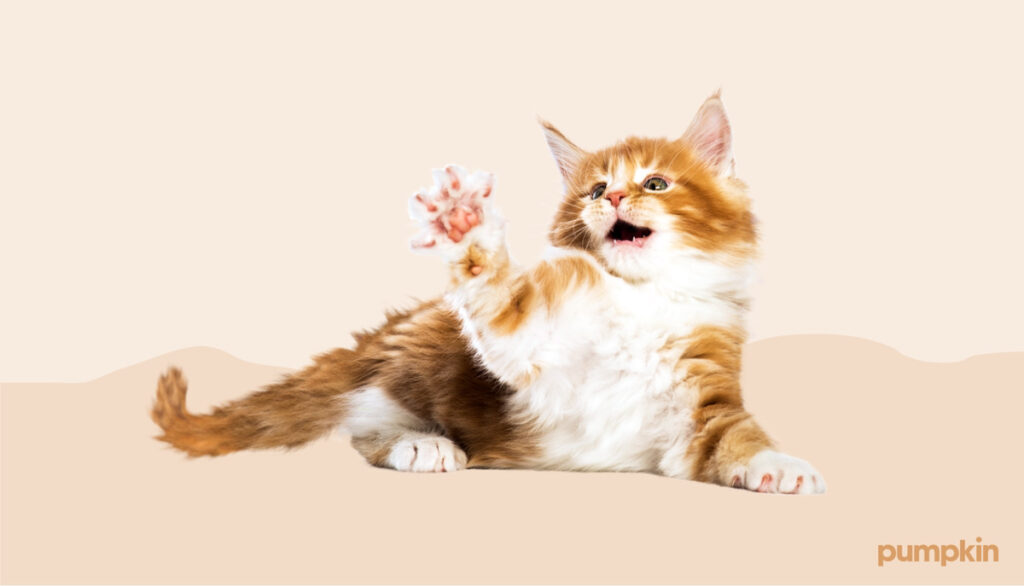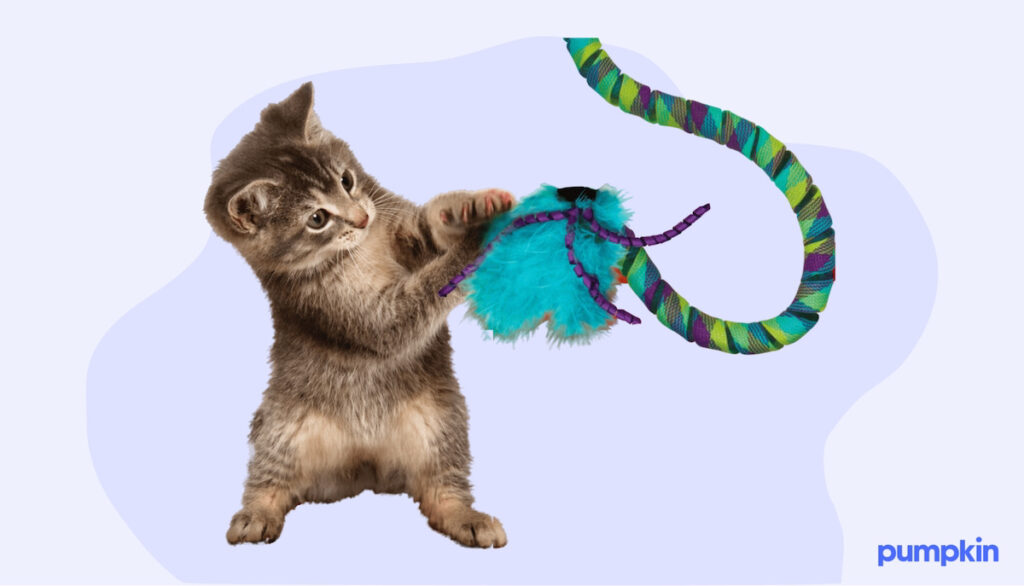Key Points
- Cats grow quickly in their first two years of life and more slowly and steadily afterward.
- A cat’s first year equals 15 human years, the second adds nine more, and each year after that is equivalent to four human years.
- The average lifespan of a cat is 12 to 18 years old.
At some point in your cat-parenting journey, you’ve probably wondered how old your cat is in human years. We all know they can have the energy of a hyperactive teenager one minute and a napping middle-aged dad the next.
You might have even tried calculating your cat’s age according to the widely accepted idea that one year of a cat’s life is equal to seven human years.
But this ratio is actually a myth, which originates from the idea that one human year equals seven dog years (which is also a myth). The reality is more complex. That’s because time moves at a different pace for cats — they develop much faster than you might expect (or want to accept) in their first months and years of life.
Let’s learn how to accurately calculate your cat’s age in human years and how to make the most of their nine lives.
How to calculate your cat’s age
So, how old is your cat in human years? The cat years to human years calculation is fairly simple. Compared to calculating a dog’s age, which can vary based on size and breed, the method to calculate a cat’s age is pretty straightforward.
According to the American Animal Hospital Association (AAHA), these age guidelines have been created and agreed upon by the AAHA, the Feline Advisory Bureau (now known as International Cat Care), and the American Association of Feline Practitioners (AAFP):
- The first year of a cat’s life is equal to approximately 15 human years.
- The second year of a cat’s life is equal to an additional nine human years.
- After the second year of a cat’s life, each additional year is equal to about four human years.
For cats two years and older, you can use this simple formula: Human Age = (Cat’s Age – 2) x 4 + 24.
Cat years to human years chart
Let’s see where your cat falls on the cat age chart:

Click here to download a printer-friendly version!
How did vets crack the code on cat years?
The AAHA bases its cat aging guidelines on the physical and behavioral changes that happen as cats grow up. These stages are then matched to the stages of human life.
In other words, a 1-year-old cat is physiologically similar to a 15-year-old teenager. At 2 years old, or 24 years old in human years, most cats have reached their full size and physical maturity, like a young twentysomething.
Of course, as with humans (and dogs for that matter), there will be small variations in the way each cat ages. These calculations are a good starting point, but your cat will age faster or slower depending on gender, genes, lifestyle, and overall health. Ultimately, calculating cat years to human years is an approximation, not a perfect comparison.
The stages of a cat’s life
The average lifespan of a cat is between 12-18 years, and they go through each life stage a lot faster than we do. Unlike human babies, kittens don’t rely on their mothers for an extended period. After a couple of months, they can be ready for adoption, whereas humans often rely on our parents until we’re 18 years old — and often a lot longer than that!
Cats also reach sexual maturity (the point at which they can reproduce) much faster, at around six months old. That’s why kittens seem to grow so quickly.
Here are the cat life stages your kitten will experience in their lifetime:
Kitten (birth to 12 months)
This is the growth phase where kittens develop rapidly. You’ll see an incredible growth spurt, both physically and cognitively.
In their first few months, they’re just like toddlers — curious, playful, and getting into everything. Expect boundless energy, zoomies, and playful sneak attacks. This is also when kittens start learning social skills. Encourage gentle play and positive reinforcement to help them grow into well-adjusted cats.
By the end of their first year, your kitten is more like a teenager than a toddler. Or, as veterinarian Dr. Sarah J. Wooten told us, “6-month-old cats are typically already sexually active teenagers, god bless them.”

Young adult (1 to 6 years old)
In this stage, cats grow to full size and reach peak physical health. Their growth has slowed down, but their physical and mental skills are still developing.
Think of them like rebellious teenagers who are eager to test boundaries and assert their independence. You might even catch some of that “teenage angst.” Make sure they’re mentally stimulated; a bored cat can all too easily take out their frustration on your couch. By the end of this phase, every cat year is equal to about four human years.
Mature adult (7 to 10 years old)
The mature stage is akin to middle age in humans. As they settle into adulthood, they will have more relaxed and established routines. They’re equivalent to a 30 to 40-year-old human at this time — comfortable in their own skin (or fur) and enjoying their prime.
Your cat’s physical growth will have stopped by now, but they will continue to mature mentally and emotionally. They’ll be perfectly happy to trade playtime for some quality snooze time.
Senior (older than 10 years)
At this stage, cats require more care and frequent health checkups as they’re more susceptible to age-related health issues. This stage is also known as geriatric.
While it’s natural for them to experience some physical and mental decline, many senior cats still have plenty of spunk and love to play. But to keep them safe and comfortable, make adjustments to their environment to accommodate any mobility issues. You can also consider pet insurance to help with the costs of caring for an older kitty.
End-of-life
The last life stage covers the changes cats go through as they near the end of his or her life. It’s a painful but natural part of the pet parenting journey.
It can be heartbreaking to see your pet slowing down, but you can still comfort and support them. Talk to your vet about end-of-life care options to fill their final days with peace and love.
On average, the life expectancy of a cat is 12 to 18 years, but some can live 20 to 25 years. In human years, that’s equivalent to reaching their 90s or 100s. The record-holder for the “oldest cat ever” lived to be 38 years and 3 days old, or 168 in human years.
Do indoor and outdoor cats age differently?
This is a controversial topic. Because outdoor cats are exposed to more risks than indoor cats, some cat parents strongly believe it’s best to keep their cats safely indoors. There are valid reasons behind both sides of the argument.
According to the AAHA, indoor cats are less likely to experience trauma and exposure to certain infectious diseases, which may result in longer lifespans. Plus, they’re safe from dangers like cars, predators, and neighborhood catfights.
However, indoor cats may be at a greater risk for illness due to environmental limitations. They need extra attention to stay healthy and happy. That means providing plenty of mental and physical stimulation, like interactive toys, climbing structures, and window perches.

Outdoor cats benefit from a more stimulating environment. They also get more exercise, mental stimulation, and exposure to natural sunlight. In fact, some cats thrive in an outdoor environment and may be unhappy or stressed cooped up inside. Still, they face a higher risk of injuries, parasites, diseases, and getting lost. Microchipping and regular vet checkups are essential to help keep them safe and healthy.
What are the signs of aging in cats?
If you know your cat’s exact age, it’s easy to calculate cat years to human years. If you don’t know your rescue or adopted cat’s true age, then look for clues to help you guesstimate. Your veterinarian can also make an educated guess based on a physical exam.
Here are some physical indicators that your cat has reached their senior life stage:
- Teeth: Yellow stains and tartar build-up, missing teeth
- Coat: Graying fur, as well as thicker, coarser fur in comparison to young cats
- Eyes: Cloudiness, tearing, and discharge
- Activity level: Less activity, weight or muscle mass loss, and arthritis
- Behavioral changes: More meowing, more wandering around, increased level of anxiety, disorientation, and signs of cognitive decline
Help your cat live a long and healthy life
So, how do you give your cat the best shot at a long life? A healthy diet, an active lifestyle, and regular wellness visits with your vet all support your cat’s health.
Regular vet checkups help you detect potential health issues sooner. Vaccinations and parasite prevention are also a must to protect them from preventable diseases. Early detection and treatment of age-related health issues, like kidney disease, cancer, and arthritis, can greatly improve their quality of life and extend their lifespan.
As your cat grows up, you may want to enroll in a pet insurance plan to help with the costs of eligible vet bills from unexpected accidents or illnesses. That way, if your cat does get sick or injured, you can focus less on cost and more on providing the best possible care.
Updated on March 4, 2025: After speaking with a veterinarian, we updated some of the figures in the “Cat Age Chart” to reflect the fact that cats reach sexual maturity much faster than humans.
- https://www.aaha.org/wp-content/uploads/globalassets/02-guidelines/feline-life-stage/felinelifestageguidelines.pdf
- https://www.vetwest.com.au/pet-library/how-long-do-cats-live-ageing-and-your-feline/
- https://www.aaha.org/resources/2021-aaha-aafp-feline-life-stage-guidelines/feline-life-stage-home/
- https://www.avma.org/resources-tools/pet-owners/petcare/senior-pets
- https://www.guinnessworldrecords.com/world-records/oldest-cat-ever
- https://vcahospitals.com/know-your-pet/feeding-growing-kittens
- https://www.vet.cornell.edu/departments-centers-and-institutes/cornell-feline-health-center/health-information/feline-health-topics/hydration




